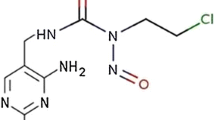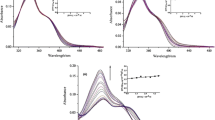Abstract
In our pursuit to expand new potential anticancer leads, a series of eighteen novel 1-cyclopropyl-6-fluoro-4-oxo-7-(4-substituted piperazin-1-yl)-1,4-dihydroquinoline-3-carboxylic acid analogues have been synthesized, characterized and evaluated anti-proliferative activity against five human cancer cell lines such as A549 (lung cancer), Mia Paca (pancreatic cancer), HeLa (cervical cancer), MDA MB-231 (breast cancer), MCF-7 (breast cancer) and normal embryonic kidney cell line (HEK) were carried out using MTT assay. Few of the synthesized analogues exhibited potent anticancer activity against the cancer cell lines at a lower concentration. The synthesized compounds showed the less toxic effect on normal human embryonic kidney cell line (HEK) compared with doxorubicin. Noticeably, compound 3o exhibited potent activity against all five cancer cell lines compared with ciprofloxacin. Further study exposed that compound 3o could competently intercalate into calf thymus DNA to form 3o-DNA complex which might block DNA replication to apply anti-proliferative activity. Docking simulation studies supported by molecular interactions with DNA type II topoisomerase. These derivates can become lead structures for the development of potential anticancer drugs.
Graphical Abstract
Eighteen CP analogues were synthesized and evaluated for anti-proliferative activity. The interactions with DNA topoisomerase II were supported by molecular docking studies. 3o showed promising anticancer activity than CP against MCF7 cell line and interaction with calf thymus DNA was studied by fluorescence spectroscopy.


Similar content being viewed by others
References
Cancer Facts and Figures. American Cancer Society, 2012
Yamakuchi M, Nakata M, Kawahara K, Kitajima I and Maruyama T 1997 New quinolones, ofloxacin and levofloxacin, inhibit telomerase activity in transitional-cell carcinoma cell-lines Cancer Lett. 119 213
Azema J, Guidetti B, Dewelle J, Le Calve B, Mijatovic T, Korolyov A, Vaysse J, Martino M M, Martino R and Kiss R 2009 7-((4-Substituted)piperazin-1-yl) derivatives of ciprofloxacin: Synthesis and in vitro biological evaluation as potential antitumor agents Bioorg. Med. Chem. 17 5396
El-Rayes B F, Grignon R, Aslam N, Aranha O and Sarkar F H 2002 Ciprofloxacin inhibits cell growth and synergises the effect of etoposide in hormone resistant prostate cancer cells Int. J. Oncol. 21 207
Ebisuno S, Inagaki T, Kohjimoto Y and Ohkawa T 1997 The cytotoxic effect of fleroxacin and ciprofloxacin on transitional cell carcinoma in vitro Cancer 15 2263
Herold C, Ocker M, Ganslmayer M, Gerauer H, Hahn E G and Schuppan D 2002 Ciprofloxacin induces apoptosis and inhibits proliferation of human colorectal carcinoma cells Br. J. Cancer 86 443
Shaharyar M, Ashraf Ali M and Abdullah M M 2007 Synthesis and antiproliferative activity of 1-[(sub)]-6-fluoro-3-[(sub)]-1,3,4-oxadiazole-2-yl-7-piperazino-1,4-dihydro-4-quinolinone derivatives Med. Chem. Res. 16 292
Kozeil R, Szczepanoswska J, Magalska A, Piwocka K, Duszynski J and Zablock K 2010 Ciprofloxacin inhibits proliferation and promotes generation of aneuploidy in Jurkat cells J. Physiol. Pharmacol. 61 233
Mondal E R, Das S K and Mukherjee P 2004 Comparative evaluation of antiproliferative activity and induction of apoptosis by some fluoroquinolones with a human non-small cell lung cancer cell line in culture Asian Pac. J. Cancer Prev. 5 196
Kloskowski T, Gurtowska N, Olkowska J, Marcin Nowak J, Adamowicz J, Tworkiewicz J, Debski R, Grzanka A and Drewa T 2012 Ciprofloxacin is a potential topoisomerase II inhibitor for the treatment of NSCLC Int. J. Oncol. 41 1943
Kloskowski T, Olkowska J, Nazlica A and Drewa T 2010 The influence of ciprofloxacin on hamster ovarian cancer cell line CHO AA8 Acta Pol. Pharm. 67 345
Esmaeilzadeh A, Ebtekar M, Biglar A and Mohammad Hassan Z 2012 Influence of ciprofloxacin on glioma cell line GL26: A new application for an old antibiotic Afr. J. Microbiol. Res. 6 4891
Aranha O, Wood Jr D P and Sarkar F H 2000 Ciprofloxacin mediated cell growth inhibition, S/G2-M cell cycle arrest, and apoptosis in a human transitional cell carcinoma of the bladder cell line Clin. Cancer. Res. 6 891
Kloskowski T, Gurtowska N, Nowak M, Joachimiak R, Bajek A, Olkowska J and Drewa T 2011 The influence of ciprofloxacin on viability of A549, HepG2, A375.S2, B16 and C6 cell lines in vitro Acta Pol. Pharm. 68 859
Yogeeswari P, Sriram D, Kavya R and Tiwari S 2005 Synthesis and in-vitro cytotoxicity evaluation of gatifloxacin Mannich bases Biomed. Pharmacother. 59 501
Nieto M J, Alovero F L, Manzo R H and Mazzieri M R 2005 Benzenesulfonamide analogs of fluoroquinolones. Antibacterial activity and QSAR studies Eur. J. Med. Chem. 40 361
Gootz T D, Mcguirk P R, Moynihan M S and Haskell S L 1994 Placement of alkyl substituents on the C-7 piperazine ring of fluoroquinolones: dramatic differential effects on mammalian topoisomerase II and DNA gyrase Antimicrob. Agents Chemother. 38 130
Alovero F L, Pan X S, Morris J E, Manzo R H and Fisher L M 2000 Engineering the Specificity of Antibacterial Fluoroquinolones: Benzenesulfonamide Modifications at C-7 of Ciprofloxacin Change Its Primary Target in Streptococcus pneumoniae from Topoisomerase IV to Gyrase Antimicrob. Agents Chemother. 44 320
Robinson M J, Martin B A, Gootz T D, Mcguirk P R and Osheroff N 1992 Effects of novel fluoroquinolones on the catalytic activities of eukaryotic topoisomerase II: Influence of the C-8 fluorine group Antimicrob. Agents Chemother. 36 751
Zeng Q, Kwok Y, Kerwin S M, Mangold G and Hurley L H 1998 Design of new topoisomerase II inhibitors based upon a quinobenzoxazine self-assembly model J. Med. Chem. 41 4273
Kim M Y, Na Y, Vankayalapati H, Guzman M G and Hurley L H 2003 Design, Synthesis, and Evaluation of Psorospermin/Quinobenzoxazine Hybrids as Structurally Novel Antitumor Agents J. Med. Chem. 46 2958
Kim M Y, Duan W, Gleason G M and Hurley L H 2003 Design, Synthesis, and Biological Evaluation of a Series of Fluoroquinoanthroxazines with Contrasting Dual Mechanisms of Action against Topoisomerase II and G-Quadruplexes J. Med. Chem. 46 571
Teicher B A 2008 Next generation topoisomerase I inhibitors: Rationale and biomarker strategies Biochem. Pharmacol. 75 1262
Sanchez-Martin R, Campos J M, Conejo-Garcia A, Cruz-Lopez O, Banez-Coronel M, Rodriguez-Gonzalez A, Gallo M A, Lacal J C and Espinosa A 2005 Symmetrical bis-quinolinium compounds: new human choline kinase inhibitors with antiproliferative activity against the HT-29 cell line J. Med. Chem. 48 3354
Suresh N, Nagesh H N, Chandra Sekhar K V G, Kumar A, Shirazi A N and Parang K 2013 Synthesis of novel ciprofloxacin analogues and evaluation of their anti-proliferative effect on human cancer cell lines Bioorg. Med. Chem. Lett. 23 6292
Pigeon P, Top S, Zekri O, Hillard E A, Vessieres A, Plamont M A, Buriez O, Labbe E, Huche M, Boutamine S, Amatore C and Jaouen G 2009 The replacement of a phenol group by an aniline or acetanilide group enhances the cytotoxicity of 2-ferrocenyl-1, 1-diphenyl-but-l-ene compounds against breast cancer cells J. Organomet. Chem. 694 895
Ma L, Xie C, Ma Y, Liu J, Xiang M, Ye X, Zheng H, Chen Z, Xu Q, Chen T, Chen J, Yang J, Qiu N, Wang G, Liang X, Peng A, Yang S, Wei Y and Chen L 2011 Synthesis and Biological Evaluation of Novel 5-Benzylidenethiazolidine-2,4-dione Derivatives for the Treatment of Inflammatory Diseases J. Med. Chem. 54 2060
Upadhyaya R S, Vanadavasi J K, Vasireddy N R, Sharma V, Dixit S S and Chattopadhyaya J 2009 Design, synthesis, biological evaluation and molecular modelling studies of novel quinoline derivatives against Mycobacterium tuberculosis Bioorg. Med. Chem. 17 2830
Fukuda R, Takenaka S and Takagi M 1990 Metal ion assisted DNA-intercalation of crown ether-linked acridine derivatives J. Chem. Soc. Chem. Commun. 151028
Kapuscinski J and Darzynkiewicz Z 1985 Interactions of antitumor agents ametantrone and mitoxantrone (novatrone) with double-stranded DNA Biochem. Pharmacol. 34 4203
Dang X J, Nie M Y, Tong J and Li H L 1998 Inclusion of the parent molecules of some drugs with \(\beta \)-cyclodextrin studied by electrochemical and spectrometric methods J. Electroanal. Chem. 448 61
Li N, Ma Y, Yang C, Guo L and Yang X R 2005 Interaction of anticancer drug mitoxantrone with DNA analyzed by electrochemical and spectroscopic methods Biophys. Chem. 116 199
Mondal B, Sen B, Sarkar S, Zangrando E and Chattopadhyay P 2017 Synthesis, characterization, crystal structure and DNA-binding study of four cadmium(II) pyridine-carboxamide complexes J. Chem. Sci. 129 45
Perumal G, Jayaram R and Aziz K R 2014 Mixed-ligand binuclear copper (II) complex of 5-methylsalicylaldehyde and 2,2\(^{\prime }\)-bipyridyl: Synthesis, crystal structure, DNA binding and nuclease activity J. Chem. Sci. 126 783
Sastri C V, Eswaramoorthy D, Giribabu L and Bhaskar G M 2003 DNA interactions of new mixed-ligand complexes of cobalt(III) and nickel(II) that incorporate modified phenanthroline Ligands J. Inorg. Biochem. 94 138
Zhu T, Wang Y, Ding W, Xu J, Chen R, Xie J, Zhu W, Jia L and Ma T 2015 Anticancer Activity and DNA-Binding Investigations of the Cu(II) and Ni(II) Complexes with Coumarin Derivative Chem. Bio. Drug. Design 85 385
Baguley B C and Le Bret M 1984 Quenching of DNA-ethidium fluorescence by amsacrine and other antitumor agents: a possible electron-transfer effect Biochemistry 23 937
Chitrapriya N, Sathiya Kamatchi T, Zeller M, Lee H and Natarajan K 2011 Synthesis, spectroscopic, crystal structure and DNA binding of Ru(II) complexes with 2-hydroxy-benzoic acid [1-(4-hydroxy-6-methyl-2-oxo-2H-pyran-3-yl)-ethylidene]-hydrazide Spectrochim. Acta Part A 81 128
Lakowicz J R and Webber G 1973 Quenching of fluorescence by oxygen. Probe for structural fluctuations in macromolecules Biochemistry 12 4161
Imrich J, Sabolova D, Vilkova M and Cova J K 2016 Unexpected regiospecific formation and DNA binding of new 3-(acridin-9-yl)methyl-2-iminothiazolidin-4-ones J. Chem. Sci. 128 269
Acknowledgements
Sincere thanks to the Department of Biotechnology (No.BT/PR4801/MED/29/370/2012), Government of India, New Delhi for funding the project. The author NS thanks UGC, New Delhi for the award of senior research fellowship; we also thank Devendar for maintaining cell culture.
Author information
Authors and Affiliations
Corresponding author
Electronic supplementary material
Below is the link to the electronic supplementary material.
Rights and permissions
About this article
Cite this article
Suresh, N., Suresh, A., Yerramsetty, S. et al. Anti-proliferative activity, molecular modeling studies and interaction with calf thymus DNA of novel ciprofloxacin analogues. J Chem Sci 130, 121 (2018). https://doi.org/10.1007/s12039-018-1528-y
Received:
Revised:
Accepted:
Published:
DOI: https://doi.org/10.1007/s12039-018-1528-y




